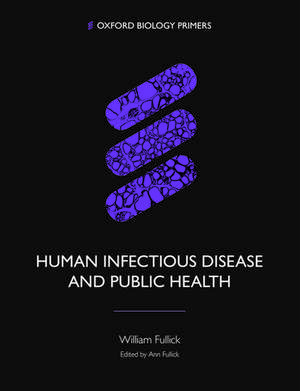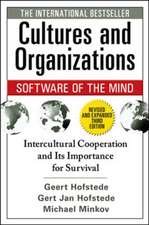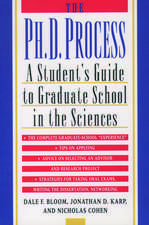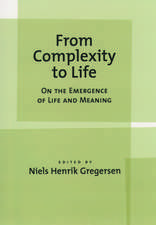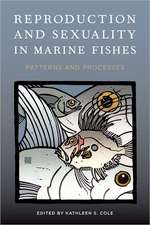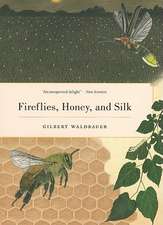Human Infectious Disease and Public Health: Oxford Biology Primers
Autor William Fullicken Limba Engleză Paperback – 4 feb 2019
Din seria Oxford Biology Primers
- 26%
 Preț: 154.69 lei
Preț: 154.69 lei - 20%
 Preț: 152.91 lei
Preț: 152.91 lei - 26%
 Preț: 152.91 lei
Preț: 152.91 lei - 20%
 Preț: 165.91 lei
Preț: 165.91 lei - 20%
 Preț: 164.31 lei
Preț: 164.31 lei - 26%
 Preț: 154.08 lei
Preț: 154.08 lei - 26%
 Preț: 154.50 lei
Preț: 154.50 lei - 20%
 Preț: 165.91 lei
Preț: 165.91 lei - 17%
 Preț: 175.25 lei
Preț: 175.25 lei - 20%
 Preț: 153.39 lei
Preț: 153.39 lei - 14%
 Preț: 165.98 lei
Preț: 165.98 lei - 13%
 Preț: 166.27 lei
Preț: 166.27 lei - 13%
 Preț: 167.59 lei
Preț: 167.59 lei - 20%
 Preț: 154.33 lei
Preț: 154.33 lei - 19%
 Preț: 167.33 lei
Preț: 167.33 lei - 20%
 Preț: 155.13 lei
Preț: 155.13 lei - 13%
 Preț: 153.79 lei
Preț: 153.79 lei - 13%
 Preț: 154.02 lei
Preț: 154.02 lei - 14%
 Preț: 152.42 lei
Preț: 152.42 lei - 13%
 Preț: 166.61 lei
Preț: 166.61 lei - 14%
 Preț: 152.69 lei
Preț: 152.69 lei
Preț: 152.73 lei
Preț vechi: 206.78 lei
-26% Nou
Puncte Express: 229
Preț estimativ în valută:
29.23€ • 31.74$ • 24.55£
29.23€ • 31.74$ • 24.55£
Carte disponibilă
Livrare economică 21-27 martie
Livrare express 15-21 martie pentru 76.27 lei
Preluare comenzi: 021 569.72.76
Specificații
ISBN-13: 9780198814382
ISBN-10: 0198814380
Pagini: 176
Dimensiuni: 190 x 248 x 8 mm
Greutate: 0.32 kg
Editura: OUP OXFORD
Colecția OUP Oxford
Seria Oxford Biology Primers
Locul publicării:Oxford, United Kingdom
ISBN-10: 0198814380
Pagini: 176
Dimensiuni: 190 x 248 x 8 mm
Greutate: 0.32 kg
Editura: OUP OXFORD
Colecția OUP Oxford
Seria Oxford Biology Primers
Locul publicării:Oxford, United Kingdom
Recenzii
A lovely introduction to human disease, delivered in plain language while using an appropriate level of scientific terms. Although aimed at students transitioning to university study, many of the topics are applicable throughout undergraduate study and beyond.
I especially appreciated the effort of placing infectious diseases in context (social, political, economic etc.), instead of focusing exclusively on the science behind them. This makes the topic much more dynamic and engaging, as it becomes a real factor influencing our day-to-day life instead of an abstract concept on a page.
I would have loved this book in my first year of college. It is a great introduction to the subject and will definitely make students eager to find out more. Reading it reminded me of why I love this subject so much and wish to make a career out of it.
The case studies peppered throughout are very valuable for students at this stage they help to introduce skills of scientific reasoning and critical appraisal of scientific research. These are skills that I generally found were not really developed at school but are of course central to university science.
Overall this book is engaging and fulfils its aim of bridging the gap between school and university science in this subject. It would certainly have been valuable to me at that stage and I did not find anything similar at that time. I would recommend this book to other students.
This book made things simple and clear to understand, something that is vital for the transitioning to degree level education. The figures and tables are a highlight; they really aid in understanding the text. This is something a lot of textbooks lack, as too much text is off putting for readers, especially those who are visual learners.
In comparison with other resources I have used on a similar topic, it is specific yet concise. Most books on this topic are usually very large and cover much detail. However, this is certainly an advantage as it makes the book very accessible and not overwhelming. I especially like the addition of aspects which causes the reader to think and question the text. The frequent Pause for thought areas work very well. The discussion questions at the end are another aspect which makes this text stand out from other similar textbooks.
This book does a brilliant job of introducing some of the more sophisticated concepts in a concise, yet informative manner. Just from flicking through the book, prior to reading it, there seems to be at least one new image or section on each page, which to me signals that the book will be succinct, and keep my interest. If theres one thing undergrads dont like, its pages and pages of unbroken text!
For a student like me, with no chemistry background, some of the molecular concepts were hard to grasp, but I feel that this book would have made the process so much easier, with its clear, colour-coded diagrams (e.g. Chapter 4 Defending against the invaders, Fig. 4.3), and straight-forward descriptions.
The content is beautifully presented and easy to read, whilst being incredibly informative. Ive had other immunology / infectious disease textbooks in the past which were five times as long, but not nearly as concise and easy to use as this one. This book also contains topics which were still relevant to me in my third-year (e.g. the complement cascade, autoimmune disorders), so its the kind of textbook which will carry you on through your whole degree.
A pleasure to read. It is concise, easy-to-use and written in a straight-forward easy-to-understand manner. I think that it compares well to other textbooks and resources which I have used to study similar topics these topics if not well presented can seem quite dry, and I think that the use of case studies in particular helps to prevent this and keep the content engaging.
This work is highly successful in providing students with a birds eye view on the subject without compromising the scientific details. It covers the full essence of the field as found in undergraduate bioscience courses.
This book provides an excellent, holistic introduction to a variety of infectious diseases and the associated public health considerations. I enthusiastically recommend this title to all aspiring biomedical researchers and liberal arts students who are eager to join this battle against different pathogens for better healthcare tomorrow.
I especially appreciated the effort of placing infectious diseases in context (social, political, economic etc.), instead of focusing exclusively on the science behind them. This makes the topic much more dynamic and engaging, as it becomes a real factor influencing our day-to-day life instead of an abstract concept on a page.
I would have loved this book in my first year of college. It is a great introduction to the subject and will definitely make students eager to find out more. Reading it reminded me of why I love this subject so much and wish to make a career out of it.
The case studies peppered throughout are very valuable for students at this stage they help to introduce skills of scientific reasoning and critical appraisal of scientific research. These are skills that I generally found were not really developed at school but are of course central to university science.
Overall this book is engaging and fulfils its aim of bridging the gap between school and university science in this subject. It would certainly have been valuable to me at that stage and I did not find anything similar at that time. I would recommend this book to other students.
This book made things simple and clear to understand, something that is vital for the transitioning to degree level education. The figures and tables are a highlight; they really aid in understanding the text. This is something a lot of textbooks lack, as too much text is off putting for readers, especially those who are visual learners.
In comparison with other resources I have used on a similar topic, it is specific yet concise. Most books on this topic are usually very large and cover much detail. However, this is certainly an advantage as it makes the book very accessible and not overwhelming. I especially like the addition of aspects which causes the reader to think and question the text. The frequent Pause for thought areas work very well. The discussion questions at the end are another aspect which makes this text stand out from other similar textbooks.
This book does a brilliant job of introducing some of the more sophisticated concepts in a concise, yet informative manner. Just from flicking through the book, prior to reading it, there seems to be at least one new image or section on each page, which to me signals that the book will be succinct, and keep my interest. If theres one thing undergrads dont like, its pages and pages of unbroken text!
For a student like me, with no chemistry background, some of the molecular concepts were hard to grasp, but I feel that this book would have made the process so much easier, with its clear, colour-coded diagrams (e.g. Chapter 4 Defending against the invaders, Fig. 4.3), and straight-forward descriptions.
The content is beautifully presented and easy to read, whilst being incredibly informative. Ive had other immunology / infectious disease textbooks in the past which were five times as long, but not nearly as concise and easy to use as this one. This book also contains topics which were still relevant to me in my third-year (e.g. the complement cascade, autoimmune disorders), so its the kind of textbook which will carry you on through your whole degree.
A pleasure to read. It is concise, easy-to-use and written in a straight-forward easy-to-understand manner. I think that it compares well to other textbooks and resources which I have used to study similar topics these topics if not well presented can seem quite dry, and I think that the use of case studies in particular helps to prevent this and keep the content engaging.
This work is highly successful in providing students with a birds eye view on the subject without compromising the scientific details. It covers the full essence of the field as found in undergraduate bioscience courses.
This book provides an excellent, holistic introduction to a variety of infectious diseases and the associated public health considerations. I enthusiastically recommend this title to all aspiring biomedical researchers and liberal arts students who are eager to join this battle against different pathogens for better healthcare tomorrow.
Notă biografică
Dr William Fullick MBBS MRCGP trained at the University of East Anglia, qualifying in 2009. He went on to complete his junior doctor years in Devon and Cornwall, rotating through a number of different medical specialities before deciding on general practice as a career and passing his Royal College of General Practitioners exams in 2015. Working part time as a GP in the West Country allows him to see a wide variety of patients, whilst also fitting in his lifelong passion for writing. William really enjoys using his medical and scientific knowledge to educate and inspire others, helping people understand more about their own bodies, the diseases that beset them and the treatments available.
